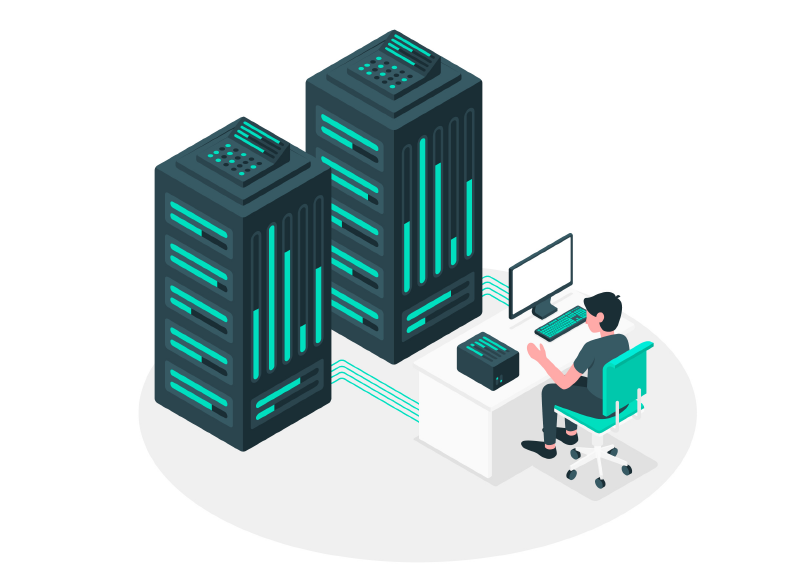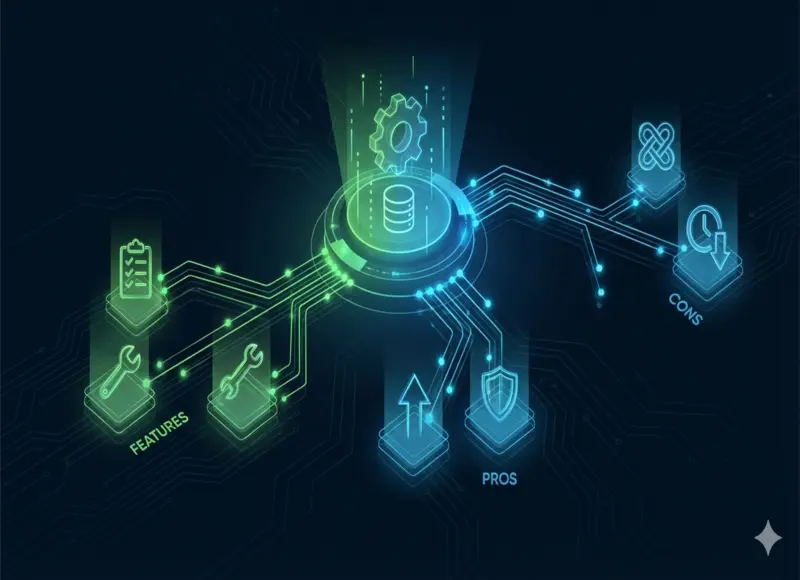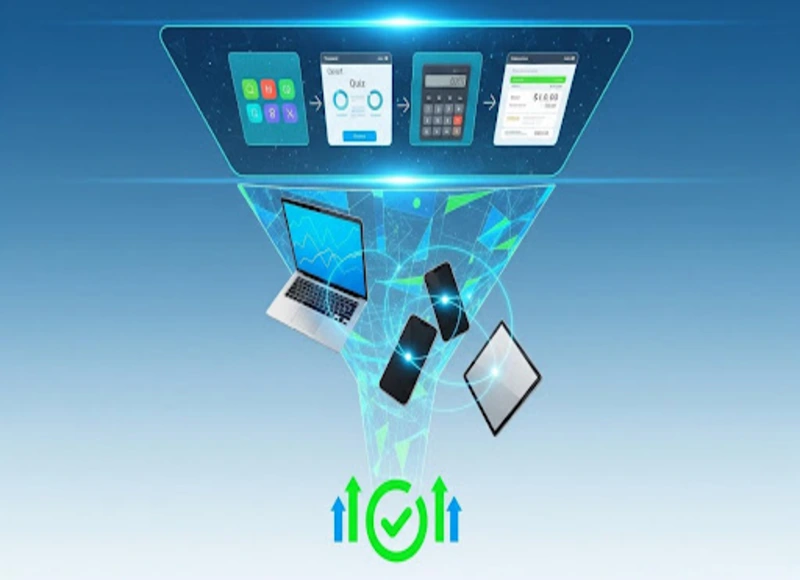Table of Contents
Explore the world of sustainable IT with our guide to green web hosting and eco-friendly app development. Start making a positive impact on the environment now!

"Going green" is more than a popular trend today. Sustainability has recently transcended mere environmental concerns and become a focal point of business operations across various industries, including IT.
Global digitization keeps gaining pace and getting more and more profound. While technology throws new opportunities at us, its impact on natural ecosystems increases exponentially. Hence, tech companies strive to reduce the negative impact of their work by adopting sustainable practices across their various functions.
In this article, we'll look into the multifaceted landscape of sustainable practices within the IT sector and explore different "green" approaches implemented by industry players to meet the needs of the present and safeguard the interests of future generations.
Why Is Sustainable IT Important?
As one of the fastest-growing industries, IT heavily influences resource consumption, carbon emissions, and waste generation. So, today, there are more than enough reasons for IT sustainability beyond the apparent ecological footprint reduction.
- Cost Savings: Energy-efficient practices will help reduce electricity bills and operational expenses, leading to tangible cost savings. While involving higher upfront costs, these solutions offer long-term benefits through reduced energy consumption, extended equipment lifespan, and lower maintenance expenses.
- Catching up With Consumer Trends: With a customer-centric approach reigning supreme across industries, IT focus on eco-friendliness will align with evolving consumer preferences. Modern consumers tend to support businesses that demonstrate environmental stewardship and social responsibility.
- Competitiveness: With customers favouring eco-friendly products and services, organizations that incorporate sustainability into their IT strategies gain a competitive edge and access to new market opportunities.
- Embracing innovation: Investments in "green" IT encourage innovation in energy-efficient technologies, renewable energy sources, and recycling processes. This, in turn, drives technological advancements and industry growth.
- Social Impact: Sustainable IT initiatives contribute to improved air and water quality. As such, they reduce health risks associated with pollution and e-waste exposure in communities.
- Regulatory Compliance: Governments worldwide tend to implement stricter environmental regulations, including restrictions on e-waste disposal and carbon emissions. Hence, it's important for IT organizations to stay compliant with these regulations to avoid fines.
All in all, eco-friendly practices will enable companies to create a more resilient and responsible IT ecosystem that benefits the planet and society. So, let's look into sustainable practices common for the IT sector in more detail.
Green Web Hosting
Traditional web hosting services typically rely on energy-intensive data centres powered by non-renewable energy sources. Producing significant carbon emissions, they cause environmental degradation. In contrast, green web hosting providers use renewable energy sources, implement energy-efficient infrastructure, and offset carbon emissions to reduce their environmental footprint.
They often invest in progressive energy projects like solar or wind farms to power their data centres. They may also employ energy-efficient hardware and cooling systems to minimize energy consumption. Some green web hosting companies also participate in carbon offset programs and fund projects that reduce greenhouse gas emissions to compensate for their operational carbon trace. While minimizing carbon discharge and overall negative impact on the environment, green web hosting helps conserve finite natural resources.
Several IT companies have already adopted green web hosting practices to maintain their general sustainability goals:
- Google has committed to powering its data centres and cloud services with 100% renewable energy. The company invests in wind and solar projects worldwide and has achieved carbon neutrality for its global operations.
- DreamHost purchases Renewable Energy Credits (RECs) to offset the carbon emissions associated with its data centres and operations.
- GreenGeeks operates energy-efficient data centres powered by wind energy and purchases carbon offsets to neutralize its carbon discharge.
Energy-Efficient Data Centers
The backbone of cloud computing, big data analytics, and online services, data centres have recently faced rapid growth, leading to increased energy consumption and carbon emissions. Data centres rely on several innovative technologies to mitigate environmental impact and improve their energy efficiency.
- Virtualization technology enables the consolidation of multiple virtual servers onto a single physical server. It helps reduce hardware requirements and energy consumption.
- Liquid cooling systems use water or specialized coolants to remove heat from servers more efficiently than traditional air-cooling methods.
- Energy-efficient hardware such as servers, storage devices, and networking equipment is distinguished by improved power management features and reduced energy consumption during idle periods.
- AI-driven algorithms can optimize data centre operations in real time. They dynamically adjust workload distribution, cooling settings, and resource allocation to maximize energy efficiency.
To further extend the sustainability and efficiency measures within these technological domains, precision agriculture solutions have emerged as a pivotal application area, leveraging data centres for processing vast amounts of data to optimize farming practices. These solutions use modern data centres' computational power and AI capabilities to analyze weather patterns, soil conditions, and crop health, enabling precise resource allocation and reducing environmental impact.
In practice, bigger industry names are already investing in energy-wise data centres. Thus, Facebook's data centre in Oregon is one of the world's most energy-efficient facilities of this type. It incorporates innovative cooling systems, renewable energy sources, and advanced server designs to ensure top-level energy efficiency.
Upcoming Trends in Energy-Efficient Data Centers
As technology advances, the future of data centres is marked by a few distinct trends.
- Edge computing decentralizes data processing and storage. It brings computing resources closer to end-users, reducing the need for large centralized data centres and improving energy efficiency.
- Modular data centre designs and containerized solutions offer scalability and flexibility while optimizing space utilization and energy efficiency.
- Green certifications such as Leadership in Energy and Environmental Design (LEED) and the Uptime Institute's Efficient IT Stamp of Approval recognize and incentivize energy-efficient data centre design and operation.
Sustainable Software Development
It's about designing, building, and maintaining software applications with minimal environmental impact while promoting social responsibility and ensuring long-term viability. Eco-friendly app development incorporates several principles:
- Efficient resource utilization to minimize energy use and reduce carbon footprint of the app;
- Minimalist design to create streamlined and lightweight apps that prioritize essential features and functionality while minimizing unnecessary complexity and resource usage;
- Renewable energy awareness by partnering with green hosting providers and platforms to power the app infrastructure;
- Lifecycle considerations to reduce the environmental impact of the entire software lifecycle, including development, deployment, maintenance, and end-of-life disposal;
- Ethical considerations such as data privacy, accessibility, and inclusivity in the design and development process to ensure that the application respects user rights and societal values.
In real life, many industry leaders have embraced eco-friendly app development practices in their operations.
- Salesforce has adopted various initiatives to reduce the environmental impact of its software products and operations. The company prioritizes energy-efficient data centres, renewable energy procurement, and carbon offsetting to keep its carbon footprint under control.
- Autodesk has developed tools and resources to help architects, engineers, and designers create sustainable buildings and infrastructure projects. The company's software products enable users to assess environmental performance, improve energy efficiency, and reduce waste throughout the design and construction process.
E-waste management and Recycling
Due to the rapid pace of tech advancement and the shortening lifecycle of electronic devices, e-waste is a growing problem in the IT sector. Discarded smartphones, laptops, tablets, and desktop computers contain hazardous materials such as lead, mercury, and cadmium, posing environmental and health risks if improperly disposed of.
As consumers upgrade to newer models or discard malfunctioning devices, outdated and obsolete electronics accumulate in landfills or are illegally exported to developing countries, where they are often disposed of unsafely, leading to pollution and health hazards.
Several effective strategies to address this problem in the IT industry include:
- Extended product lifespan: Manufacturers should design devices with durability and longevity in mind. They will be able to withstand extended use and frequent upgrades without becoming obsolete.
- Modular design: Modular design principles allow for easy repair, upgrade, and component replacement. They prolong the lifespan of electronic devices and reduce the need for disposal.
- Product reuse and refurbishment: Companies should encourage consumers to donate or sell their used electronics for reuse or refurbishment rather than discarding them.
- Product take-back programs: Special programs allow customers to return old or unwanted electronics for responsible disposal or Recycling.
- Eco-design and eco-labelling: Integration of environmental considerations into product design and labelling, such as energy efficiency ratings, recyclability indicators, and eco-friendly materials, will inform consumers and promote sustainable purchasing decisions.
Responsible E-Waste Disposal
To mitigate environmental and health risks associated with e-waste, IT industry stakeholders can responsibly treat disposal and Recycling by sticking to the following practices:
- Establishing certified e-waste recycling facilities equipped with proper infrastructure and technology to safely dismantle, process, and recycle electronic devices.
- Recovery of valuable materials such as metals, plastics, and rare earth elements from electronic devices to maximize resource recovery and minimize waste.
- Safe handling and disposal of hazardous materials contained in electronic devices, such as batteries, circuit boards, and displays, to prevent environmental contamination and health hazards.
- Prioritizing data security and privacy during e-waste disposal and recycling to protect sensitive information stored on e-devices.
E-Waste-Related Initiatives by IT Companies
- Apple offers a recycling program that allows customers to return their old Apple devices for refurbishment. The company also incorporates recycled materials into new product designs and aims to transition to a closed-loop supply chain to further minimize waste.
- Dell offers free Recycling of electronics for consumers and businesses and uses recycled materials in product packaging. The company's goal is to increase the recyclability of its products through design innovations.
- HP enables customers to return products for responsible Recycling or refurbishment. Besides, they design products with recyclability in mind and use recycled materials in product manufacturing.
Future Prospects for IT Sustainability
IT companies play a critical role in driving innovation, addressing global challenges, and promoting sustainable development. This tendency will keep gaining pace, with the main focus on a few areas.
- Continued Innovation: Tech organizations will keep generating advanced sustainability technologies and practices, driving progress toward carbon neutrality, circular economy principles, and ethical AI.
- Collaboration: Collaboration and partnerships across industry sectors, governments, and civil society will be essential to address complex sustainability challenges such as climate change, digital inclusion, and supply chain transparency.
- Stakeholder Engagement: IT solutions companies should focus on building strong ties and connections with stakeholders and responding to their evolving expectations to maintain trust, credibility, and legitimacy in the eyes of customers, investors, and the public.
To Conclude
In a world driven by digital technology, IT sustainability is no longer a choice—it is a necessity and a long-term commitment. IT sustainability focuses on minimizing the environmental impact of digital infrastructure while maintaining performance, security, and scalability. Organizations can optimize data centers by adopting energy-efficient hardware, virtualization, cloud migration, and advanced cooling strategies to reduce emissions and operational costs. Sustainable IT also encompasses responsible device lifecycle management, recycling initiatives, and environmentally conscious procurement standards.
Aligning technology operations with a business electricity plan that prioritizes renewable energy can significantly reduce an organization’s carbon footprint. By tracking energy consumption, automating workloads, and designing efficient software, IT teams enable long-term resilience, regulatory compliance, and brand trust—while continuing to drive innovation without placing unnecessary strain on the environment. To remain competitive, IT companies must rethink traditional business models and embrace holistic, responsible operational practices. By adopting eco-friendly strategies today, organizations can future-proof their businesses and contribute to a more sustainable and prosperous world for future generations.
Recent Blogs
Key Benefits of Hiring Nearshore React.js Development Teams for Enterprise Projects
-
20 Jan 2026
-
10 Min
-
127
Stop Building from Scratch: Boost Your Marketing Funnel with App Templates
-
13 Jan 2026
-
10 Min
-
467







